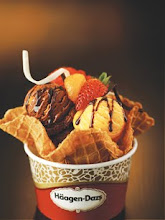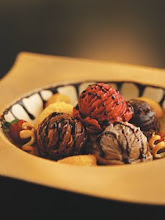2009/02/15
Food of the Gods
Audrey Vijaindren
Erra Fazira trying her hand at tempering liquid chocolate at the chocolate classworkshop facilitated by Chef Amer Hamzah. — Pictures by Halimaton Saadiah Sulaiman.
A SENSUAL feeling that consumes your body and takes over your mind. The sensation of complete and utter bliss that will not let you rest until you've satisfied the craving.
Much like love, chocolate touches you in the most unreachable places, warming all your senses at once. And that's why many Malaysians are turning to the "food of the Gods" in search of ecstasy.
Chocolate factories are sprouting up all over the country and chocolate-making classes are filling up with hands eager to create their own magic.
Model, singer and actress Erra Fazira is one of the many women who have embarked on this journey.
"I love the taste and feel of chocolate. When I'm busy at work, Snickers bars are my substitute for lunch. Chocolate-making will come in handy during festive seasons. I make many hampers for Hari Raya and this will be a great addition. Now, instead of buying treats, I can give a gift of love that I've made myself."
Erra, who's a month away from delivering a baby, says it's the perfect time for her to join a chocolate-making class as she has a lot of time on her hands.
"I'm sure once the baby arrives I'll be busy being a mother, so I want to do this now. I'm even toying with the idea of starting my own chocolate brand.
"One day, I hope to make, package and sell my chocolates online. I've never done it before and it would surely give me a great sense of accomplishment."
Kolej Damansara Utama School of Hospitality, Tourism and Culinary Arts started its first basic chocolate-making course last week.
The two-month course is taught by Chef Amer Hamzah, who began his career with a job at the Malaysian Cocoa Board before venturing into the industry. The award-winning master chocolatier's clientele include royalty, ministers and other prominent people.
The first company he worked for was Quantum Supplies (M) Sdn Bhd, now known as Fidani Chocolatier Sdn Bhd, which operates the country's largest hand-made chocolate factory and for whom he developed the house brands Fidani, Farell's and Danson.
He also developed private labels for Malaysia Airlines, Famous Amos and for foreign markets.
"Chocolate is my life," says Amer. "You could say I'm trapped in a chocolate world. I learned to cook from my parents. Since I was 8, I've been making Malay kuih, briyani rice, etc. I'm proud to be the first Malaysian to create chocolates for Van Houten."
Teaching people to make chocolate, he says, is his satisfaction.
"In Malaysia, we're still trying to find our identity. In the chocolate world we're still rojak-rojak. I hope, one day, we will get to the premium point.
"Look at the Taiwanese bread and how they've marketed themselves. We've got the best cocoa butter in the world, there's no reason why we can't do it."
"Malaysians love to eat chocolate but they think making it is too difficult. So, they'd rather spend loads of money buying it. But once you try making it, you'll know that it's not as hard as it seems.
"The art of making chocolate is not like other forms of cooking. It's all in the appreciation of the whole process. It's a matter of self-satisfaction."
What makes chocolate sexy?
Amer says it's the association it has with self-indulgence. It's a luxury. It just melts in your mouth. What other food can do that?
"Chocolate has an image of prestige. It adds value to anything, be it cake or ice-cream. And it's connected with loving someone. From kids to adults, there's no limitation, no discrimination. It unites everyone."
Is there a best time in the day to eat chocolate?
"No, not really. But eat when you're tired or feeling down or frustrated and it will give you an instant lift.
"My four kids are huge chocolate fans and even try to eat it for breakfast. But because they know the difference, they won't settle for less than the best."
But what about that waistline?
"All the myths about chocolate making you fat, causing tooth decay and pimples are not true. But because as kids it was too expensive for our parents to afford chocolates, those were the stories we heard.
"In fact, chocolate is good for you. It gives quick energy. You can skip a meal and eat a bar of chocolate."
What's your personal favourite?
"There are so many, but I can't resist dark chocolate filled with orange or peppermint."
The truth about chocolate
CHOCOLATE is a 'happy' food. When we eat it, we produce endorphins, a family of small proteins, in the brain.
They enhance the sensory properties of chocolate, such as the aroma, taste and mouth-feel, contributing to our on-going sensation of pleasure and well-being.
Myth Chocolate makes you fat.
Truth It is the amount consumed that will determine whether it contributes to body fat.
MythChocolate raises blood cholesterol and blood glucose levels a lot.
Truth It doesn't raise levels too much. Chocolate provides nutrients and antioxidants, making it a healthy snack when eaten in moderation.
Myth Chocolate causes acne.
Truth Poor diet is the real culprit. Hormonal changes at puberty coupled with a diet lacking in zinc and high in iodine are also high on the list of suspects.
Myth Chocolate causes tooth decay.
Truth Tooth decay is not the domain of sugar alone. Most starches and sugar have the potential to cause dental caries. Tannin in cocoa may help prevent caries by reducing the growth of plaque.
Turning points in chocolate lore
• The scientific name for cocoa is Theobroma cocoa, Latin for “food of the Gods”.
• The first cocoa trees grew wild in the tropical rain forests of the Amazon and Orinoco river basins over 4,000 years ago.
• About 400 cocoa beans are needed to produce one pound of chocolate.
• In 1502, Christopher Columbus, on his voyage to the Caribbean, was introduced by the Aztecs to Xocolatl (cocoa drink) and took some
beans back to Spain.
• The Spaniards added hot water, sugar, vanilla and cinnamon, and the drink became all the rage among European nobles.
• Cocoa beans were used as currency by the Aztecs (four nibs could buy a rabbit and 100 nibs a slave).
• In 1600, the Dutch transplanted cocoa trees to their East Indian states of Java and Sumatra, from there they spread to the Philippines, New Guinea and the rest of Indonesia.
• 50 years later, the chocolate drink reached England.
• The first chocolate factory in Britain was established in 1728.
• In 1828, the Dutchman C. J. Van Houten discovered a method for removing the fat from cocoa, which became cocoa butter.
• Van Houten also invented a method to treat cocoa powder with alkali in order to darken the colour and give it a milder flavour.
• From this discovery, the production of chocolate bars and slabs began.
•¸In 1831, the Englishman John Cadbury developed cocoa drinks by adding milk.
• Chocolate bars were invented by Joseph Storrs Fry, and he established a chocolate company in Switzerland.
• Henri Nestle and Daniel Peter experimented adding condensed milk to cocoa, cocoa butter and sugar, making the first milk chocolate.
• In 1857, Milton Hershey was born in Pennsylvania. He started the world’s largest chocolate manufacturing plant called Hershey.
• The first filled chocolates appeared in Belgium in 1913.
• In 1930, candy bars such as Mars and Kit Kat were invented.
• Lindt launched its 70 per cent cocoa chocolate bar in 1989. It was the first supermarket brand to do so.
• Bitter chocolate is made by mixing cocoa paste with small amounts of sugar. Milk chocolate is a mixture of cocoa paste, cocoa butter, sugar, and substantial quantities of powdered milk. White chocolate is obtained by mixing cocoa butter, sugar and milk.
Sunday, February 15, 2009
Subscribe to:
Post Comments (Atom)































No comments:
Post a Comment